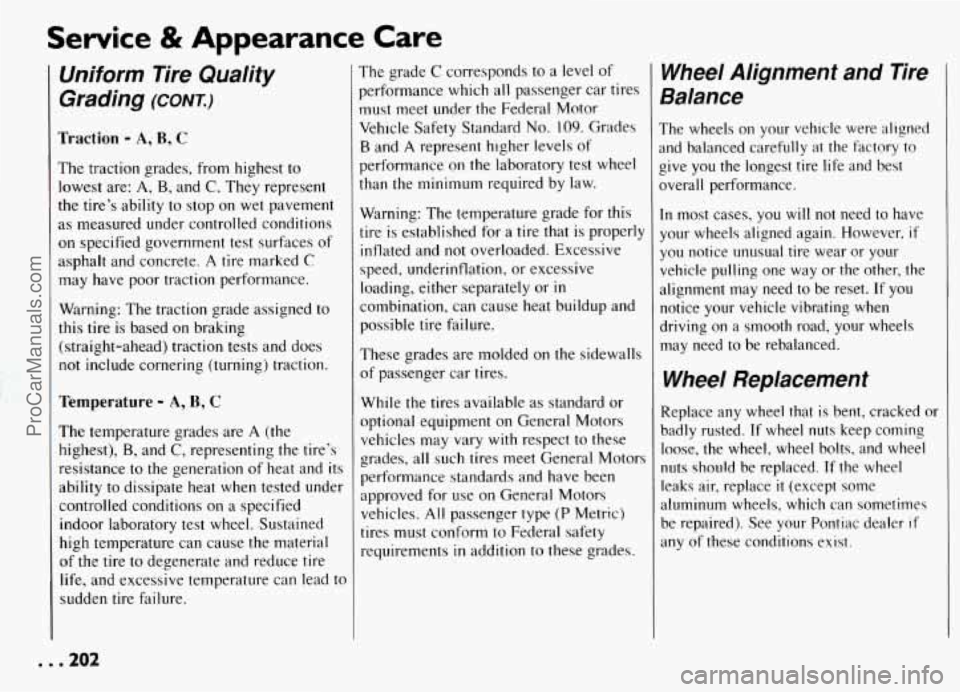Page 166 of 274
9. Remove any rust or dirt from the
wheel bolts, mounting surfaces or
spare wheel.
1O.Place the spare on the wheel mounting
surface.
11,.Replace the wheel nuts with thg
rounded.end of the nuts toward the
wheel. Tighten each nut
by hand until
the wheel
is held against the hub. ‘4 : d-;. .I !I .+ ..$:!7
p ,
165...
ProCarManuals.com
Page 203 of 274

Service & Appearance Care
Uniform Tire Quality
Grading
(CONT.)
Traction - A, B, C
The traction grades, from highest to
lowest are: A,
B, and C. They represent
the tire’s ability to stop on wet pavement
as measured under controlled conditions
on specified government test surfaces of
asphalt and concrete.
A tire marked C
may have poor traction performance.
Warning: The traction grade assigned to
this tire is based on braking
(straight-ahead) traction tests and does
not include cornering (turning) traction.
Temperature - A, B, C
The temperature grades are A (the
highest),
B, and C, representing the tire’s
resistance to the generation
of heat and its
ability to dissipate heat when tested under
controlled conditions on a specified
indoor laboratory test wheel. Sustained
high temperature can cause the material
of the tire to degenerate and reduce tire
life, and excessive temperature can lead to
sudden tire failure.
The grade C corresponds to a level of
performance which all passenger car tires
must meet under the Federal Motor
Vehicle Safety Standard
No. 109. Grades
B and A represent higher levels of
performance on the laboratory test wheel
than the minimum required by law.
Warning: The temperature grade for this
tire is established for a tire that is properly
inflated and not overloaded. Excessive
speed, underinflation, or excessive
loading, either separately or
in
combination, can cause heat buildup and
possible tire failure.
These grades are molded on the sidewalls
of passenger car tires.
While the tires available as standard or
optional equipment on General Motors
vehicles may vary with respect to these
grades, all such tires meet General Motors
performance standards and have been
approved for use on General Motors
vehicles. All passenger type
(P Metric)
tires must conform to Federal safety
requirements
in addition to these grades.
Wheel Alignment and Tire
Balance
The wheels on your vehicle were aligned
and balanced carefully
at the factory to
give you the longest tire life and best
werall performance.
[n most cases, you will not need to have
your wheels aligned again. However,
if
you notice unusual tire wear or your
vehicle pulling one way or the other, the
alignment may need to be reset. If you
notice your vehicle vibrating when
driving on a smooth road, your wheels
may need to be rebalanced.
Wheel Replacement
Replace any wheel that is bent, cracked or
badly rusted. If wheel nuts keep coming
loose, the wheel, wheel bolts, and wheel
nuts should be replaced. If the wheel
leaks air, replace
it (except some
aluminum wheels, which can sometimes
be repaired). See your Pontiac dealer
if
any of these conditions exist.
. . .202
ProCarManuals.com
Page 204 of 274

Your dealer will know the kind of wheel
you need.
Each new wheel should have the same
load carrying capacity, diameter, width,
offset, and be mounted the same way as
the one
it replaces.
If you need to replace any of your wheels,
wheel bolts, or wheel nuts, replace them
only
with new GM original equipment
parts. This way, you
will be sure to have
the right wheel, wheel bolts, and wheel
nuts for your Pontiac model.
NOTICE:
The wrong wheel can also cause
problems
with bearing life, brake
cooling, speedometer/odometer
calibration, headlight aim, bumper
height, vehicle ground clearance,
and tire or tire chain clearance to the
body and chassis.
Used Replacement Wheels
‘ire Chains
NOTICE:
If your Pontiac has P195/70R14,
P2 15/60VR 14, P195/65R 15 or
P205/55R16 size tires, don’t use tire
chains; they can damage your
vehicle.
If you have other tires, use tire
chains only where legal and on
when you must. Use only
SAE
Class “S” type chains that are the
proper size for your tires. Install
them on the front tires and tighten
them as tightly
as possible with the
ends securely fastened. Drive slowly and follow the chain
manufacturer’s instructions. If you
can hear the chains contacting your
vehicle, stop and retighten them. If
the contact continues, slow down
until- it stops. Driving too fast with
chains on will damage your vehicle.
lr
ProCarManuals.com